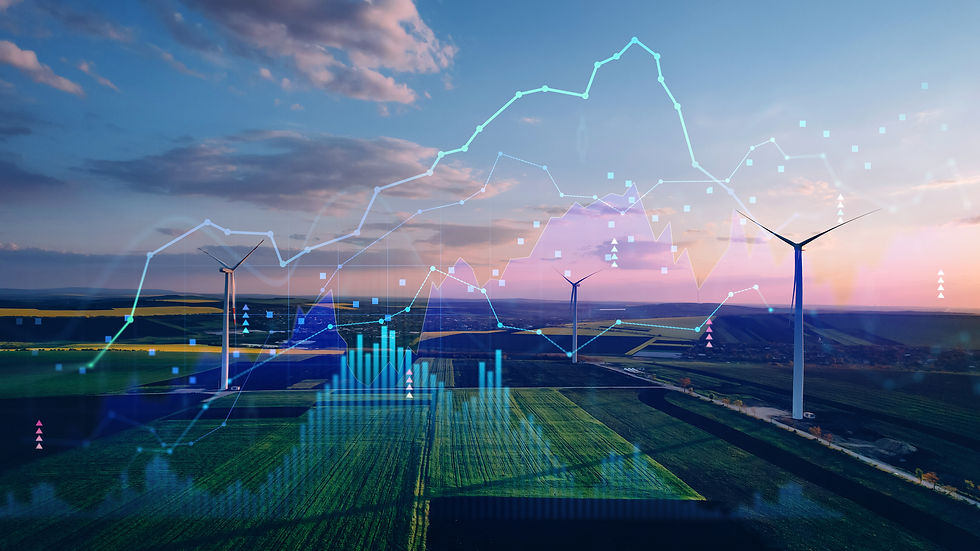Reducing Data Center Energy Costs: How HVAC Optimization Cuts Carbon Emissions
- Ava Montini

- Jan 28
- 4 min read
Data centers are the invisible engines driving our digital economy, supporting everything from video streaming to cloud computing and e-commerce. However, they have an enormous energy footprint. In particular, cooling systems—designed to prevent overheating and ensure server performance—are among the most energy-intensive components of these facilities.
By examining the nuances of cooling challenges, the role of HVAC filters, and real-world solutions, let's explore how data centers can significantly reduce energy costs and carbon emissions without compromising performance.

The Energy-Intensive Nature of Cooling in Data Centers
Walk into a typical data center, and you’re greeted by the constant hum of servers, each generating heat as they operate 24/7. Managing this heat load is critical to prevent server failure, downtime, or even catastrophic equipment damage. Yet, cooling systems, while essential, consume a staggering amount of energy.
Why Cooling is So Energy-Intensive
Relentless Operation
Unlike commercial office buildings or industrial facilities, which have peak and off-peak times, data centers require continuous cooling. The need for uninterrupted service means cooling systems operate at full capacity 365 days a year.
Dense Heat Loads
Modern servers pack immense computational power into small physical footprints. As server density increases, the amount of heat generated per square foot skyrockets. High-density data center racks can indeed generate heat loads exceeding 30 kW per rack, while traditional systems typically range between 5 to 10 kW per rack. This significant increase in power density presents challenges for cooling and energy efficiency.
Cooling System Inefficiencies
Many data centers still rely on older HVAC technologies designed for less demanding environments. These systems often lack advanced features like variable-speed drives or intelligent controls, resulting in wasted energy.
Air Distribution Challenges
Poorly designed airflow management leads to inefficiencies. Hot spots in the server room can force cooling systems to overcompensate, driving up energy use.
The Scale of Energy Use
The average data center consumes between 10 and 50 megawatts of power annually, with cooling alone accounting for 30-40% of this usage. According to the Uptime Institute, cooling inefficiencies represent one of the biggest opportunities for energy savings in data centers.
Filters
The Overlooked Hero of HVAC Efficiency
When it comes to cooling system optimization, much attention is given to technologies like liquid cooling or airflow containment. However, the role of air filters is often underestimated. These small, replaceable components significantly influence how efficiently HVAC systems operate.
How Filters Impact Energy Consumption
Filters are designed to trap particulate matter, dust, and contaminants, ensuring clean air circulates through data centers.
However, not all filters are created equal:
High-Resistance Filters: Traditional pleated filters create substantial resistance in airflow, forcing HVAC fans to work harder to push air through the system. This increases energy demand and operating costs.
Low-Pressure Drop Filters: Advanced filters with low-pressure drop technology reduce airflow resistance, enabling cooling systems to maintain efficiency while consuming less energy.
The Domino Effect of Poor Filtration
Using inefficient filters doesn’t just waste energy—it creates a ripple effect of operational problems:
Increased Wear on Fans and Motors: Higher resistance shortens the lifespan of HVAC components.
Hot Spot Risks: Poor airflow management leads to uneven cooling, forcing systems to overwork.
Dust Accumulation: Ineffective filters allow particulate matter to settle on server components, increasing the risk of overheating and equipment failure.
Real-World Benefits of Optimized Filters
Implementing advanced filters tailored for data center environments yields measurable benefits that go far beyond energy savings.
1. Energy Savings at Scale
Switching to low-resistance filters can reduce HVAC energy consumption by, on average, 15%, depending on the system's configuration. For large-scale data centers, this translates to savings in the hundreds of thousands annually.
Case Study
A California data center upgraded its filters and saw a 15% reduction in HVAC-related energy use within a year, saving over $75,000 while cutting its carbon emissions by 300 metric tons—equivalent to planting 5,000 trees.
2. Prolonged Equipment Lifespan
Cleaner air leads to less strain on HVAC systems and server components. Advanced filters trap contaminants that would otherwise accumulate on heat exchangers, fans, and server hardware, reducing maintenance costs and prolonging equipment life.
3. Enhanced Cooling Performance
By improving airflow dynamics, optimized filters eliminate hot spots and ensure consistent cooling throughout the facility. This stabilizes operating temperatures, improving server reliability and reducing unplanned downtime.
4. ESG Alignment and Carbon Reduction
As corporations face increasing pressure to meet environmental, social, and governance (ESG) goals, HVAC optimization offers a practical path forward. According to the U.S. Environmental Protection Agency, for every megawatt-hour saved, data centers can reduce their carbon emissions by approximately 0.4 metric tons.
Beyond Filters
A Comprehensive Approach to Cooling Efficiency
While advanced filters are a game-changer, they are most effective when integrated into a broader cooling optimization strategy.
1. Airflow Containment Systems
Hot aisle/cold aisle containment ensures efficient airflow management by separating hot and cold air streams. This reduces the workload on HVAC systems and improves overall energy efficiency.
2. Smart Cooling Controls
AI-driven cooling technologies can monitor temperature, humidity, and airflow in real time, adjusting HVAC performance to meet dynamic needs. Pairing smart systems with advanced filters amplifies efficiency gains.
3. Transitioning to Renewable Energy
Integrating renewable energy sources, such as solar or wind, with efficient cooling systems further reduces a data center’s environmental footprint.
A Vision for Sustainable Data Centers
The story of data centers is one of both opportunity and responsibility. As the backbone of modern technology, these facilities have an obligation to operate sustainably. Advanced air filtration represents a simple yet powerful lever for change, enabling data centers to reduce energy demand, enhance reliability, and align with global climate goals.
Small changes can lead to big results. Advanced filters, though often overlooked, can redefine the energy efficiency of data centers. Coupled with strategic airflow management and cutting-edge technologies, they are key to transforming data centers into models of operational excellence and sustainability.





















